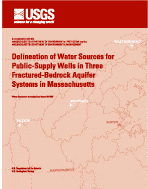
Delineation of Water Sources for Public-Supply Wells in Three Fractured-Bedrock Aquifer Systems in Massachusetts
Water-Resources Investigations Report 02-4290
By Forest P. Lyford, Carl S. Carlson, and Bruce P. Hansen

Fractured-bedrock aquifer systems in West Newbury, Maynard, and Paxton, Massachusetts, were studied to advance methods of data collection and analysis for delineating contributing areas to public-supply wells completed in fractured rock and for determining the effects of pumping on streams and wetlands. Contributing areas, as defined for this study, include all areas through which ground water flows from recharge areas to wells.
In West Newbury, exploratory public-supply wells at two locations were completed in phyllite of the Eliot Formation. Aquifer testing indicated that subhorizontal and steeply dipping fractures that parallel two sets of foliation form elongated transmissive zones in the bedrock aquifer near the two well locations and also form a vertical hydraulic connection to surficial materials consisting of till at one location and marine clay at the other location. Recharge to bedrock is largely through a thin veneer of till over bedrock, but leakage through thick drumlin tills also recharges bedrock. Simulated contributing areas for the three supply wells pumped at a combined rate of 251 gallons per minute encompass about 1.3 square miles and extend to ground-water divides within most of a subbasin of the Artichoke River. Pumping likely would reduce streamflow in the Artichoke River subbasin by approximately the pumping rate. Pumping is likely to affect wetland areas underlain by till near the wells because of the vertical hydraulic connection to surficial materials.
In Maynard, three exploratory public-supply wells were completed in coarse-grained schist of the Nashoba Formation. Aquifer testing indicated that a dense network of fractures in bedrock forms a laterally extensive transmissive zone in bedrock that is well connected vertically to surficial materials consisting of sandy till, lacustrine silts, sand and gravel, and wetland deposits. The simulated contributing area for the three supply wells pumped at a combined rate of 780 gallons per minute encompasses about 1.8 square miles of the Fort Pond Brook drainage area. Pumping likely would reduce streamflow in Fort Pond Brook by about the same amount as the pumping rate, and wetland-water levels within a 2,000-foot radius from the wells are likely to be lowered below the land surface by pumping.
In Paxton, three existing supply wells are completed in granofels and schist of the Paxton and Littleton Formations. Aquifer testing demonstrated that a shallow bedrock well completed to a depth of 150 feet is closely connected hydraulically to overlying till. Two deep wells, however, receive much of their water from fractures at depths below 500 feet. Ground-water flow in bedrock appears to be mostly through parting fractures along a foliation set that dips gently (10 degrees) eastward. These parting fractures at depth are poorly connected vertically to shallow bedrock
Abstract
Introduction
Purpose and Scope
Acknowledgments
Study Methods
Well Installation
Geologic Mapping
Borehole Geophysics
Hydrologic Data Collection
Aquifer Testing
Positioning of Data-Collection Points and Location Identifiers
Numerical Modeling
Knowles and Andreas Well Sites, West Newbury, Massachusetts
Geology
Bedrock
Surficial Geologic Units
Ground-Water-Flow Patterns and Water-Level Fluctuations
Ground-Water Recharge
Aquifer Testing and Observed Hydrologic Responses to Pumping
Hydraulic Properties of Geologic Units
Numerical Model
Areal Extent and Boundary Conditions
Horizontal and Vertical Discretization
Model Stresses
Hydraulic Properties
Alternative Models for Uncertainty Analysis
Model-Simulated Heads
Simulated Contributing Areas to Wells
Simulated Effects of Pumping on Streamflow and Wetlands
Rockland Avenue Well Site, Maynard, Massachusett
Geology
Bedrock
Surficial Geologic Units
Ground-Water-Flow Patterns and Water-Level Fluctuations
Ground-Water Recharge
Aquifer Testing and Observed Hydrologic Responses to Pumping
Hydraulic Properties of Geologic Units
Numerical Model
Areal Extent and Boundary Conditions
Horizontal and Vertical Discretization
Model Stresses
Hydraulic Properties
Alternative Models for Uncertainty Analysis
Model-Simulated Heads
Simulated Contributing Areas to Wells
Simulated Effects of Pumping on Streamflow and Wetlands
Leicester Well Site, Paxton, Massachusetts
Geology
Bedrock
Surficial Geologic Units
Ground-Water-Flow Patterns and Water-Level Fluctuations
Ground-Water Recharge
Aquifer Testing and Observed Hydrologic Responses to Pumping
Hydraulic Properties of Geologic Units
Numerical Models
Areal Extent and Boundary Conditions
Horizontal and Vertical Discretization
Model Stresses
Hydraulic Properties
Model-Simulated Heads
Simulated Contributing Areas to Wells
Simulated Effects of Pumping on Streamflow and Wetlands
Summary and Conclusions
References Cited
Appendix 1. Considerations for Determining Contributing Areas to Wells and Aquifer System Responses to Pumping in Crystalline Bedrock
Information Sources and Data-Collection Methods
Water-Level Data
Transmissivity of Geologic Units
Bedrock Surface
Recharge and Leakage Rates
Storage Properties
Transient Simulation of Contributing Areas
Streamflow and Wetland Responses to Pumping
Appendix 2. Definitions of Geologic Terms
This report is presented in Portable Document Format (PDF).
To view
and print report you will need to use PDF Viewer or Adobe Acrobat Reader
(available as freeware).
Users with visual
disabilities can visit this site for conversion tools and information to
help make PDF files more accessible.
PDF version of report:
title
page, table of contents, West Newbury site; pp. 1 to 39
Maynard
site, pp. 40 to 63
Paxton
site, pp. 63 to 113
The citation for this report, in USGS format, is as follows:
Lyford, F.P., Carlson, C.S. and Hansen, B.P., 2003, Delineation of Water Sources for Public-Supply Wells in Three Fractured-Bedrock Aquifer Systems in Massachusetts: U.S. Geological Survey Water-Resources Investigations Report 02-4290, 114 p.
For more information about USGS activities in Massachusetts-Rhode Island District, visit the USGS Massachusetts-Rhode Island Home Page.
| AccessibilityFOIAPrivacyPolicies and Notices | |
 |
|